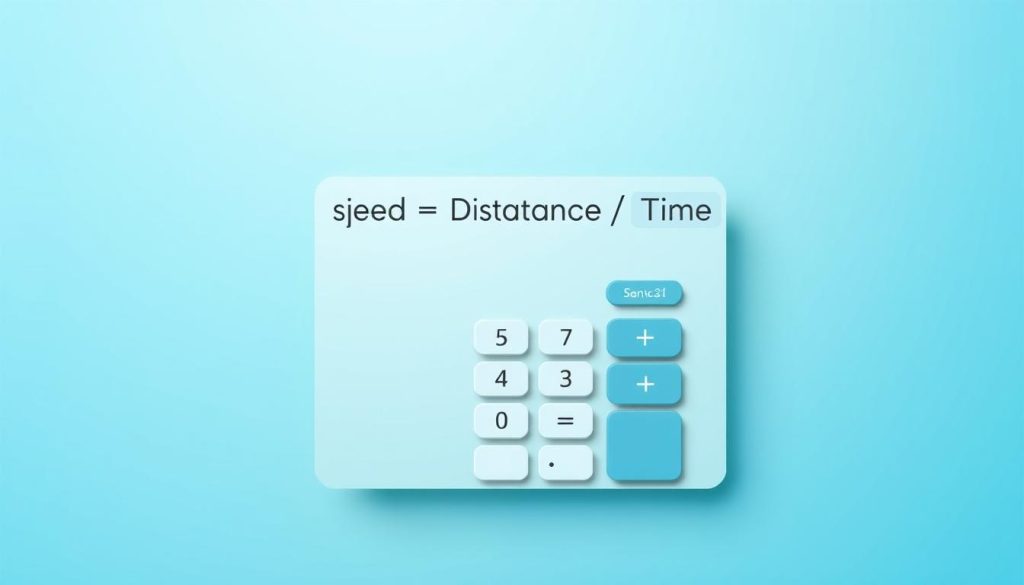Speed calculations are crucial in many real-world situations. A speed calculator helps determine velocity accurately. It’s useful for tracking athletic performance and planning road trips.
Speed measures how fast an object moves. It’s calculated by the distance covered in a specific time frame1.
Simple formulas reveal the link between speed, distance, and time. Scientists and athletes use velocity calculators to measure movement. These tools work in various contexts2.
Speed measurements offer fascinating insights. The Peregrine falcon reaches over 200 mph. Usain Bolt sprints at an impressive 27.44 mph3.
To calculate speed, divide total distance by total time. This method works for different units. You can use kilometers per hour, miles per hour, or meters per second3.
Key Takeaways
- Speed is calculated by dividing distance by time
- Multiple units can measure speed effectively
- Speed calculations apply to various fields
- Understanding velocity helps predict movement
- Mathematical formulas simplify speed tracking
Understanding Speed, Distance, and Time Relationships
Speed helps us grasp how objects move through space. It involves the link between distance traveled and time taken. The speed formula measures motion in everyday travel and scientific research4.
The speed formula is simple: speed equals distance divided by time. This equation helps us understand motion in various scenarios. A person typically walks at about 5 km/hour4.
An online speed calculator can quickly determine precise measurements for different types of movement.
What is Speed and How is it Measured?
Speed is the rate at which an object covers distance. Objects move at widely different speeds:
- Walking speed: Around 5 km/hour4
- Light speed: Approximately 300,000 km/second4
- Spacecraft speed: Up to 57,600 km/hour4
Basic Units of Measurement
Speed calculations use various units of measurement:
- Metric units: meters per second (m/s)
- Imperial units: miles per hour (mph)
- Astronomical units: kilometers per second
Real-world Applications of Speed Calculations
Speed calculations have many practical uses. They help us plan travel routes and understand astronomical distances. The basic speed formula applies to commuter trains and light travel4.
Speed isn’t just a number—it’s a way of understanding how objects move through space and time.
Calculate Speed Using Essential Formulas
Speed calculation helps us grasp motion in various scenarios. It’s done by dividing distance traveled by time taken. This simple formula works for tracking vehicles and analyzing scientific experiments.
The speed formula has three main variations. These are speed = distance ÷ time, distance = speed × time, and time = distance ÷ speed5. For example, a car going 50 kilometers in one hour has an average speed of 50 km/h.
Speed can be shown in different units. These include meters per second (m/s) or kilometers per hour (km/h). The conversion factor is 1 m/s equals 3.6 km/h5.
Scientists often use an instant speed calculator for precise measurements. Short time intervals help estimate instantaneous speed. For instance, a car covering 20 meters in 1.6 seconds moves at 12.5 m/s or 45 km/h5.
Relative motion is key in speed calculations. Speed is always measured in relation to another object or reference point5. This concept is crucial for accurate speed measurements.
Mastering speed formulas gives insights into motion and distance. It’s useful for planning trips or analyzing scientific data. Practice these calculations to become skilled at translating movement into numbers6.
FAQ
What exactly is speed?
How do I calculate speed using the basic formula?
What are the different units used to measure speed?
Can I calculate time or distance if I know the speed?
Why is understanding speed calculation important?
How do I convert between different speed units?
What common mistakes should I avoid when calculating speed?
Are there digital tools to help calculate speed?
Source Links
- How to calculate speed, distance and time – BBC Bitesize – https://www.bbc.co.uk/bitesize/articles/zcr3tv4
- How To Calculate Speed, Distance And Time Using A Triangle – https://www.practiceaptitudetests.com/resources/how-to-calculate-speed-distance-time/
- Speed Calculator – https://www.omnicalculator.com/everyday-life/speed
- 4.1: Relationship Between Distance, Speed, and Time – https://phys.libretexts.org/Bookshelves/Astronomy__Cosmology/Big_Ideas_in_Cosmology_(Coble_et_al.)/04:_Moving_Through_Space/4.01:_Relationship_Between_Distance_Speed_and_Time
- Speed and Velocity – https://www.mathsisfun.com/measure/speed-velocity.html
- Relative Speed – Meaning, Explanation, Formula and Train-based Questions – https://www.vedantu.com/physics/relative-speed
